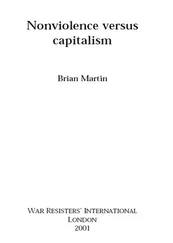In the case of military research, the end product is usually a piece of technology or occasionally an idea such as a behavioural technique. Technologies are tested by engineers in laboratories and then by military personnel in special facilities. The ultimate test is in war. Note that in the applied end of military R&D, the process moves out of the hands of the engineering professionals and into the hands of military professionals. The rest of the population is normally not involved. There are exceptions, though, such as fallout shelters for survival of nuclear attacks. Building fallout shelters makes little sense unless people are willing and able to use them, and this requires education and training of the entire population.
There are also many cases where skills and experience are relevant to both civilian and military tasks, as in the case of pilots who can fly either civilian or military aircraft and electrical engineers who can set up either civilian or military power systems. In the case of rifles, some civilians have an indirect input into military design, since they use the weapons, or related ones, for nonmilitary purposes such as hunting. Nevertheless, as a rough generalisation it can be said that military R&D is largely an in-house process, with minimal involvement by people other than military scientists, engineers and personnel. This is because the military enterprise — at least in the form it has taken in western high-technology professionalised forms — does not require active participation by the rest of the population. In the case of fuel-air explosives, for example, no “members of the public” are involved, except as casualties.
Nonviolent struggle is quite a different proposition. It is founded on popular support and involvement. Although not everyone has to participate, a considerable level of participation is essential to its success. Whereas most combat soldiers are young, fit men, anyone who wants to, regardless of age, sex or abilities, can participate in some form of nonviolent action. [4] . Obviously, not everyone is able to participate in every form of nonviolent action. For example, using a short-wave radio to send messages requires certain skills and technology. But virtually everyone can participate in petitions, rallies, boycotts, strikes and other forms of noncooperation. On participation by people with disabilities, see Brian Martin and Wendy Varney, “Nonviolent action and people with disabilities,” Civilian-Based Defense, Vol. 15, No. 3, Year-End 2000, pp. 4-16.
Therefore, science and technology for nonviolent struggle, if they are to be effective, must be developed with the active support and participation of the ultimate users of the ideas and artefacts. This means that the “method” of doing science needs to involve more of the population.
Testing a method of nonviolent action usually means a field test with a large cross-section of the population. This might be planting fruit and nut-bearing trees to make communities more self-sufficient in food or designing factories so that they can be safely and easily shut down if taken over by an aggressor. The implication is that R&D for nonviolent struggle, to be effective, would require close liaison with numerous community groups, from local gardeners to factory workers. The equivalent of soldiers testing out a new rifle would be a community testing of a new communication procedure.
Consider, for example, radio systems. Military radio systems need only be tested within the military itself. Radio for nonviolent struggle needs to be tested by all who are likely to use it. If cheap, reliable and easy-to-use short-wave systems are to be introduced throughout the society, then extensive tests need to be carried out with all sectors of the population, including groups such as children and people with impaired hearing. The military can develop radio systems and then recruit or train specialists to operate them. Radio for nonviolent struggle, by contrast, needs to be useable by all. Therefore, the design and development phases require input from likely users. In other words, the development process must be responsive to a wider section of the population than is the case for military technology.
Military and nonviolence R&D are alike in that science and technology are never developed solely in the minds of intellectuals or in remote labs: there is always a process of social interaction, including the motivation, funding, training and applications for R&D. Where these alternatives differ, in this regard, is in the social groups of greatest significance to the R&D process.
The so-called scientific revolution was made possible by combining theoretical work, carried out by gentlemen philosophers, with practical skills possessed by the much lower status artisans. Modern science thrives on the theory-practice interaction. Currently it is shaped predominantly by links with the state, corporations and the military. An alternative direction would be created by forging links with grassroots social action and life. In a sense, this would be an extension of the original scientific revolution, expanding the constituency of scientific and technological production beyond professional scientists and engineers and their primary patrons to the general public.
The difference in the development process can be pictured in the following way. For military R&D, scientists, engineers and military testing are somewhat insulated from other influences. “External” social influences on military science and technology exist, to be sure — examples include strategic policy, competition for funding, and influence of the peace movement. But a key “social influence” is actually the very organisation of the R&D as a professional, in-house enterprise.
In a more participatory process of R&D for nonviolent struggle, there would be no clear distinction between researchers and the rest of the population. Of course, some people may be much more active than others in the process of technological innovation. But in this model, such innovation depends vitally on interaction and cooperation with a wide cross-section of the population. Furthermore, this interaction and cooperation is likely to lead to contributions by others — those who in the military model would be simply users of the technology. This participatory model of R&D undermines the special role and status of professional scientists and engineers as the exclusive holders of expertise about science and technology. [5] . There is a considerable literature on citizen participation in technological decision making. See for example Malcolm L. Goggin (ed.), Governing Science and Technology in a Democracy (Knoxville: University of Tennessee Press, 1986); Alan Irwin, Citizen Science: A Study of People, Expertise, and Sustainable Development (London: Routledge, 1995); Frank N. Laird, “Participatory analysis, democracy, and technological decision making,” Science, Technology, & Human Values, Vol. 18, No. 3, Summer 1993, pp. 341-361; Brian Martin (ed.), Technology and Public Participation (Wollongong: Science and Technology Studies, University of Wollongong, 1999); James C. Petersen (ed.), Citizen Participation in Science Policy (Amherst: University of Massachusetts Press, 1984); Richard E. Sclove, Democracy and Technology (New York: Guilford Press, 1995); Leslie Sklair, Organized Knowledge: A Sociological View of Science and Technology (St. Albans: Paladin, 1973); Langdon Winner (ed.), Democracy in a Technological Society (Dordrecht: Kluwer, 1992). However, most of this writing sees citizens as involved in decision making but not actually doing research. On science by the people, see Brian Martin,“The goal of self-managed science: implications for action,” Radical Science Journal , No. 10, 1980, pp. 3-17; Brian Martin,“Anarchist science policy,” The Raven, Vol. 7, No. 2, Summer 1994, pp. 136-153; Richard Sclove, “Research by the people, for the people,” Futures, Vol. 29, No. 6, 1997, pp. 541-549. Relevant here are the diverse experiences in participatory action research, though such “people’s research” is far more likely to be in fields of social analysis rather than science and engineering. See for example Stephen Kemmis and Robin McTaggart (eds.), The Action Research Planner (Geelong, Victoria: Deakin University, 3rd edn, 1988); Robert A. Rubinstein, “Reflections on action anthropology: some developmental dynamics of an anthropological tradition,” Human Organization , Vol. 45, No. 3, Fall 1986, pp. 270-279; William Foote Whyte (ed.), Participatory Action Research (Newbury Park, CA: Sage, 1991); Trevor Williams, Learning to Manage our Futures: The Participative Redesign of Societies in Turbulent Transition (New York: Wiley, 1982).
Читать дальше












